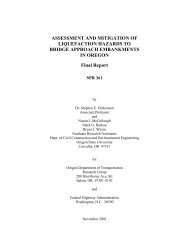Oregon Balance of State HIV/AIDS Housing & Services Systems ...
Oregon Balance of State HIV/AIDS Housing & Services Systems ...
Oregon Balance of State HIV/AIDS Housing & Services Systems ...
Create successful ePaper yourself
Turn your PDF publications into a flip-book with our unique Google optimized e-Paper software.
<strong>Oregon</strong> <strong>HIV</strong>/<strong>AIDS</strong> <strong>Housing</strong> and <strong>Services</strong> <strong>Systems</strong> Integration Plan—Appendices A-41<br />
Appendix 3: <strong>HIV</strong>/<strong>AIDS</strong> <strong>Housing</strong> Options<br />
This section describes each <strong>HIV</strong>/<strong>AIDS</strong> housing continuum type and its relative advantages and<br />
disadvantages. In addition, eligible HOPWA activities within each housing assistance type are<br />
noted. HOPWA may be used to fund some <strong>of</strong> these activities if approved within the Consolidated<br />
Plan or grant agreements.<br />
These housing assistance program options are included for reference for the reader and for future<br />
program planning.<br />
Generally, <strong>HIV</strong>/<strong>AIDS</strong> housing needs fall into an overall, community-wide housing continuum. This<br />
continuum, which provides a comprehensive way <strong>of</strong> evaluating a community’s resources, divides housing<br />
needs and resources into the following categories, each <strong>of</strong> which are explained in detail in this section:<br />
• Emergency <strong>Housing</strong> Assistance<br />
• Transitional <strong>Housing</strong> Assistance<br />
• Permanent <strong>Housing</strong> Assistance<br />
• <strong>Services</strong> to Support <strong>Housing</strong> Stability<br />
There are many different methods for delivering each <strong>of</strong> the above housing services. The charts in this<br />
section outline many <strong>of</strong> the housing solutions for each category <strong>of</strong> housing services, and summarize the<br />
advantages and disadvantages <strong>of</strong> each program type. Please note that many different funding sources may be<br />
required to establish any <strong>of</strong> these programs, and that each funding source may have restrictions that disallow<br />
certain program activities.<br />
In addition, many <strong>of</strong> the best housing resources for people living with <strong>HIV</strong>/<strong>AIDS</strong> are provided by<br />
mainstream organizations that serve a wide variety <strong>of</strong> people. It is usually faster, cheaper, and more<br />
appropriate to draw on mainstream housing resources than to create new facilities and services just for<br />
people living with <strong>HIV</strong>/<strong>AIDS</strong>. Training other providers to understand the special needs <strong>of</strong> people living with<br />
<strong>HIV</strong>/<strong>AIDS</strong> can provide the same result as, and <strong>of</strong>ten more efficiently than, providing a new service tailored<br />
to specific needs. New <strong>HIV</strong>/<strong>AIDS</strong> housing programs should focus on filling gaps not covered by other<br />
community resources or adapting mainstream resources to meet the needs <strong>of</strong> people living with <strong>HIV</strong>/<strong>AIDS</strong>.

















